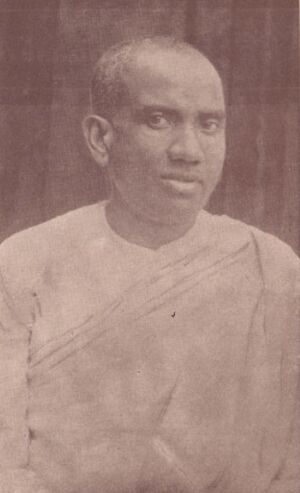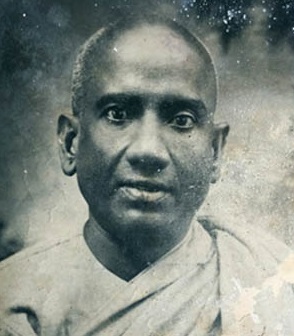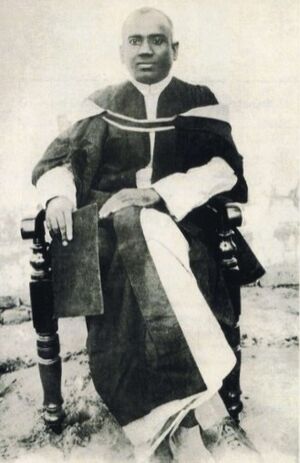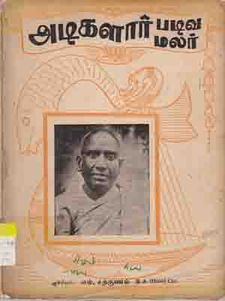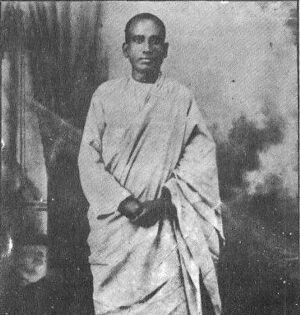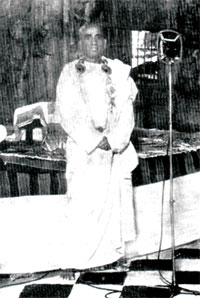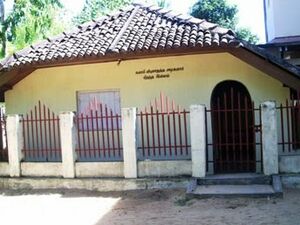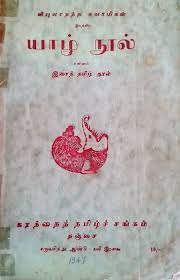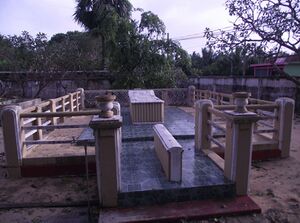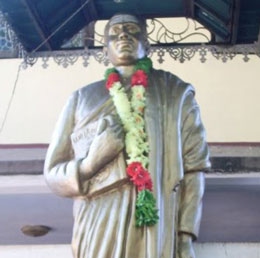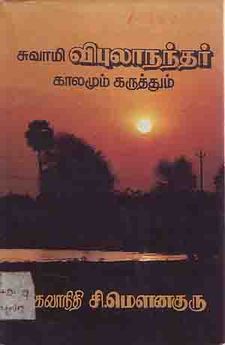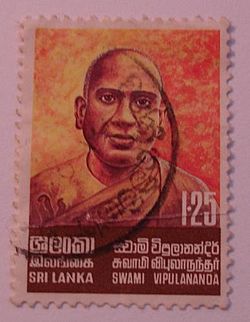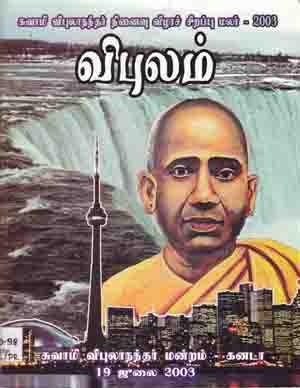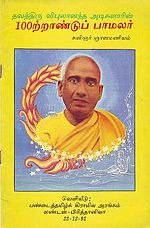Swami Vipulananda: Difference between revisions
No edit summary |
Priyamvada r (talk | contribs) No edit summary |
||
| Line 1: | Line 1: | ||
{{Read Tamil|Name of target page=சுவாமி விபுலானந்தர்|Title of target page=சுவாமி விபுலானந்தர்}} | {{Read Tamil|Name of target page=சுவாமி விபுலானந்தர்|Title of target page=சுவாமி விபுலானந்தர்}} | ||
[[File:Vipulanandar.jpg|alt=Vipulanandar|thumb|Swami | [[File:Vipulanandar.jpg|alt=Vipulanandar|thumb|Swami Vipulananda]] | ||
[[File:விபுலானந்தர்12.jpg|thumb| | [[File:விபுலானந்தர்12.jpg|thumb|Swami Vipulananda]] | ||
Swami | Swami Vipulananda (March 27, 1892 - July 19, 1947) was a Tamil musicologist, professor and monk. He was a polymath whose works spanned literature, religion, philosophy, science and music. Swami Vipulananda undertook extensive research work in Tamil music, Tamil literature, Tamil drama and linguistics. His most important works are ''[[யாழ்நூல்|Yazh Nool]],'' a treatise on the history of music and the ''Madhanga Soolamani,'' a study on drama. He is best known as the author of the ''[[யாழ்நூல்|Yazh Nool]]'' which is considered as one of the original source texts on the history of Tamil music. | ||
== Birth and | == Birth and Education == | ||
Swami Vipulananda was born on March 27, 1892 in Karaitivu located in Eastern Province of Sri Lanka to Samithambi and Kannamma. His given name was Mayilvakanan. In 1921, he joined the Ramakrishna Mission and was renamed Prabodha Chaithanyar. He became known as Vipulananda when he was ordained a monk. | |||
Swami Vipulananda received his early education in the veranda school system from Kunchithampi, a teacher. While he went on to receive an English education, he studied Tamil and Sanskrit with Vaithiyanatha Desikar, a priest at the Pillaiyar Temple in Karaitivu. | |||
[[File:Swami-vibulanthar- .jpg|alt=Swami-vibulanthar-_.jpg |thumb|Swami | [[File:Swami-vibulanthar- .jpg|alt=Swami-vibulanthar-_.jpg |thumb|Swami Vipulananda as student]] | ||
Swami Vipulananda studied at Kalmunai Methodist English School and later at St. Michael's College, Batticaloa. There, he developed an interest in mathematics thanks to a Frenchman, Rev. Bonnell. After passing the Cambridge Senior Examination at the age of 16, Swami Vipulananda worked for some time as a teacher at St. Michael's College. | |||
He joined the Teacher Training College in Colombo | He joined the Teacher Training College in Colombo. While working as a lecturer there, Swami Vipulananda studied ancient Tamil literature with Thenkovai Kandaiya Pillai. Apart from Thenkovai Kandaiya Pillai, Karaitivu Vaithilinga Desikar, and Kailayapillai are also known to be Vipulananda’s Tamil teachers. He participated in the examination conducted by the Madurai Tamil Sangam and obtained the title of ''Pandithar''. Swami Vipulananda was the first Sri Lankan to receive this title. | ||
In 1915, he joined the Colombo Government College of Technology to study science and received his Bachelor of Science (BSc) degree in 1916. In 1920 he passed the BSc examination conducted by the University of London. | |||
In his foreword to ''Swami Vipulananda -'' ''Kalamum Karuthum,'' [[Maunaguru|C. Maunaguru]], highlights five aspects of Swami Vipulananda's life that played a great role in shaping his personality. These include: | |||
* Traditional Tamil learning | * Traditional Tamil learning | ||
* English education | * English education | ||
| Line 21: | Line 21: | ||
* Association with the Ramakrishna Mission | * Association with the Ramakrishna Mission | ||
* Knowledge of multiple languages | * Knowledge of multiple languages | ||
[[File:அடிகளார் படிவமலர்.jpg|thumb|Swami | [[File:அடிகளார் படிவமலர்.jpg|thumb|Swami Vipulananda Memorial Book]] | ||
== Personal Life == | == Personal Life == | ||
* In 1912 worked as a teacher for two years at St. Michael's College, Batticaloa | * In 1912, Swami Vipulananda was certified as a trained teacher at the Teacher Training College. He then worked as a teacher for two years at St. Michael's College, Batticaloa | ||
* | * He worked as a Assistant Lecturer of Chemistry in Government Technical College, Colombo. | ||
* In 1917 worked as a science teacher at Sampatharisiyar College, Jaffna. | * In 1917, Swami Vipulananda worked as a science teacher at Sampatharisiyar College, Jaffna. | ||
* | * Later, at the request of Advocate Thiruvilangadhar, he accepted the post of Principal of Manipay Hindu College. | ||
* | * Starting 1925, he served as Manager, Trincomalee Koneswara Hindu College | ||
* | * He later accepted its Presidency in 1928. | ||
* From 1926-1930 he was in Trincomalee and also served as the Manager of Ramakrishna Mission’s Vaitheeswara Vidyalaya, Jaffna. | * From 1926-1930 he was in Trincomalee and also served as the Manager of Ramakrishna Mission’s Vaitheeswara Vidyalaya, Jaffna. | ||
===== Teaching ===== | ===== Teaching ===== | ||
| Line 34: | Line 34: | ||
* Manipay Hindu College (1920) | * Manipay Hindu College (1920) | ||
* Annamalai University (1931-1933) | * Annamalai University (1931-1933) | ||
[[File:விபுலானந்தர்.jpg|thumb| | [[File:விபுலானந்தர்.jpg|thumb|Swami Vipulananda]] | ||
===== Monastic | ===== Monastic Life ===== | ||
Swami Vipulananda started the Vivekananda Sabha at his home in Anaibandi, Jaffna in 1916 with the help of artist Kalaipulavar Navaratnam, S. Mayilvakanam and C. Muthukumaru. When Sarvanandar, the head of the Mylapore Ramakrishna Mission, came to Sri Lanka in 1917, the Vivekananda Sabha organised his reception in the country. In line with the idea mooted by Vivekananda Sabha, the Ramakrishna Mission took over the dilapidated Vaitheeswara Vidyalaya in Jaffna and helped run it. While working in Manipay, Swami Vipulananda was trained in certain aspects of yoga by a monk named Yogaswamy. | |||
In 1922, Swami Vipulananda resigned as a teacher and joined the Ramakrishna Mission. At the Mylapore Monastery in Chennai, he was administered the Brahmacharya initiation and Sannyasa initiation under the name of Prabodha Chaithanyar, by Swami Sarvananda. Swami Vipulananda studied there for two years. In 1924, on the full moon day in the month of Chittirai, he received the monastic title from Swami Sivananda, a student of Vivekananda. After that, he returned to Sri Lanka and coordinated Ramakrishna Mission's initiatives in the field of education. A ''Saiva Siddanthi'' in his early days, he went on to become an absolutist Vedantin. He instituted the practice of common seating and common meals for everyone, wherever he taught. | |||
[[File:விபுலானந்தர் சிதம்பரம்.jpg|alt=விபுலானந்தர் சிதம்பரம்.jpg|thumb|Swami | [[File:விபுலானந்தர் சிதம்பரம்.jpg|alt=விபுலானந்தர் சிதம்பரம்.jpg|thumb|Swami Vipulananda in Chidambaram]] | ||
As the President of the Jaffna Youth Union, Swami Vipulananda was in charge of welcoming Gandhi on his visit to Sri Lanka in 1927. When the Annamalai University was started in 1931, at the invitation of Raja Sir Annamalai Chettiar, Swami Vipulananda went to Chidambaram and accepted the post of Tamil Professor. In 1933, he returned to Sri Lanka to continue his work at the Ramakrishna Mission. In 1937 he travelled to Mount Kailash in the Himalayas. In 1939 he moved to the Mayawati Ashram in Almora, at the foothills of the Himalayas, and served as the editor of the ''Prabhuda Bharatha'', the English magazine of Ramakrishna Mission. There he began his work on ''[[யாழ்நூல்|Yazh Nool]]''. (Adapted from an article by S. Ambigaibagan, Swwami Vipulananda's assistant. Adigalar Pativamalar Internet Library <ref>[https://noolaham.org/wiki/index.php?title=%E0%AE%85%E0%AE%9F%E0%AE%BF%E0%AE%95%E0%AE%B3%E0%AE%BE%E0%AE%B0%E0%AF%8D_%E0%AE%AA%E0%AE%9F%E0%AE%BF%E0%AE%B5_%E0%AE%AE%E0%AE%B2%E0%AE%B0%E0%AF%8D_1969&uselang=ta AdigaLar padiva malar - 1969 - Internet Library - noolagam.org]</ref>) | |||
== Journalism == | == Journalism == | ||
Swami Vipulananda was the editor-in-chief of the following magazines. | |||
* ''Vedanta Kesari'' (English) | * ''Vedanta Kesari'' (English) | ||
* ''Prabhuda Bharatha'' (English) | * ''Prabhuda Bharatha'' (English) | ||
* ''Ramakrishna Vijayam'' (Tamil) | * ''Ramakrishna Vijayam'' (Tamil) | ||
== Literary life == | == Literary life == | ||
[[File:விபுலானந்தர் நினைவில்லம்.jpg|thumb| | [[File:விபுலானந்தர் நினைவில்லம்.jpg|thumb|Swami Vipulananda Memorial Home]] | ||
Swami Vipulananda was the editor of the Tamil magazine ''Sri Ramakrishna Vijayam'' run by the the Ramakrishna Mission and the English language magazine ''Vedanta Kesari''. He was appointed as the selector of the ''Pandithar'' examination conducted by the [[நான்காம் தமிழ்ச்சங்கம்|Fourth Tamil Sangam]], Madurai. He wrote literary articles for the Sangam's magazine, ''[[செந்தமிழ் (இதழ்)|Senthamizh]]''. | |||
===== Literary Criticism ===== | ===== Literary Criticism ===== | ||
Swami Vipulananda wrote during a period when literary criticism was just coming into vogue in Tamil. He tried to formulate principles that could be used to analyze both traditional and modern literary forms. His notable essays include ''Nagariga varalaru, Egiptiya nagareegam, Yavanapurakkalai selvam, Metrisai selvam, Aiyamum azhagum, Unmaiyum vadivum, Nilavum pozhilum, Malayum kadalum, Kaviyum salbum and Nadum nagarum.'' He believed that Tamil literature must be read and analyzed in the context of Tamil culture. He also believed that it must be contrasted against world cultures and analysed vis-a-vis other artforms. | |||
===== Translation ===== | ===== Translation ===== | ||
Vipulananda's | Swami Vipulananda's translation of some English poems into Tamil were published as a collection titled ''Angilavani''. His translation of poems by Walter Scott (The Lady of the Lake), Tennyson (In Memoriam), Milton, Wordsworth, Keats are notable. He translated Shakespeare's plays, which were published as a book called ''Madanga Soolaamani.'' | ||
===== Coinage of Technical Terms (Terminology/Glossary) ===== | ===== Coinage of Technical Terms (Terminology/Glossary) ===== | ||
The Technical Terms Coinage Academy was formed in 1934 under the leadership of Swami Vipulananda | The Technical Terms Coinage Academy was formed in 1934 under the leadership of Swami Vipulananda. In 1938, the glossary ‘Technical Terms' (''Kalai Chorkal'')’ was published by the Chennai Tamil Sangam. Swami Vipulananda emphasized the need to coin new terminology in Tamil and create unique words in the language for corresponding English words. (For instance, the word ''kannadi'' is used for both a mirror and a piece of glass. Swami Vipulananda wanted unique words to be coined for each concept). He did not have rigid views about translation. To not deviate from the meaning of the source, was central to his philosphy of translation. | ||
Led by Swami Vipulananda, a conference on Tamil terminology was held on 20 September 1936 at Pachaiyappa College Hall, Chennai. Scholars from University of Chennai, Government of Sri Lanka, South Indian Teachers' Association and South Indian Tamil Association attended the conference. Swami Vipulananda served as the Chairman of the Terminology Committee and the Chairman of the Chemistry Glossary Committee. The Madras Provincial Tamil Conference held on September 27, 1936, passed a resolution in praise of his efforts to create new technical terms. | |||
== Music | == Music Research == | ||
[[File:யாழ் நூல்.jpg|alt=Yazh Nool|thumb|Yazh Nool]] | [[File:யாழ் நூல்.jpg|alt=Yazh Nool|thumb|Yazh Nool]] | ||
Swami | In 1931, when Swami Vipulananda became the first Tamil professor at Annamalai University, he undertook research on early Tamil music. In 1934, while at the Mayawati Ashram in Almorah, Himalayas, he began writing a book entitled ''[[யாழ்நூல்|Yazh Nool]],'' which he completed later while working in Sri Lanka. | ||
== Drama | == Drama Research == | ||
One of Swami | One of Swami Vipulanada’s most notable contributions was his attempt to formulate a modern grammar for Tamil dramatics. He wrote a book called ''Madanga Choolamani'' analyzing Shakespeare’s plays on the basis of the principles of dramatics found in Tamil literary texts. | ||
== Spirituality == | == Spirituality == | ||
Swami | Swami Vipulananda was attracted by the ideals of the Ramakrishna Mission. He found his calling there and became a monk in that order. [[Maunaguru|C.Maunaguru]] describes his spiritual journey thus - “Swami Vipulananda started out as a ''saiva siddhantin''. But in later years he appears to have become a staunch, absolutist Vedantin” | ||
== Awards == | == Awards == | ||
* In recognition of Swami Vipulananda's service to the Eelam people, Sri Lanka awarded him the title of National Hero. | |||
* In recognition of | |||
* Tamil Language Day is observed on the day of his death in all schools in Sri Lanka. | * Tamil Language Day is observed on the day of his death in all schools in Sri Lanka. | ||
== Death == | == Death == | ||
[[File:விபுலானந்தர் சமாதி.jpg|alt=விபுலானந்தர் சமாதி.jpg|thumb|Swami | [[File:விபுலானந்தர் சமாதி.jpg|alt=விபுலானந்தர் சமாதி.jpg|thumb|Swami Vipulananda Memorial]] | ||
Swami Vipulananda returned to Sri Lanka in a critical condition after the launch of his book ''Yazh Nool''. He passed away on July 19, 1947. His body was buried under a tree in front of the Sivananda Vidyalaya, which he had created in Batticaloa. | |||
== Statue of | == Statue of Vipulananda == | ||
Under the leadership of Dr. Ma. Parasuraman, Vipulananda’s statue was erected in front of the Vipulananda Public Library on the main road in Karaitivu, 22 years after Vipulananda's death. The statue was | Under the leadership of Dr. Ma. Parasuraman, Vipulananda’s statue was erected in front of the Vipulananda Public Library on the main road in Karaitivu, 22 years after Vipulananda's death. The statue was unveiled on October 08, 1969 by Kunrakkudi Adigalar who was visiting from India. During the unveiling ceremony of the statue, ''Adigalar Padivamalar,'' a book compiled by the writer Ma. Sargunam M.A. was released. The statue was destroyed during the 1990 genocide. | ||
[[File:விபுலானந்தர் சிலை.jpg|alt=விபுலானந்தர்_சிலை.jpg|thumb|Swami | [[File:விபுலானந்தர் சிலை.jpg|alt=விபுலானந்தர்_சிலை.jpg|thumb|Swami Vipulananda's Statue]] | ||
In 1999, another statue was erected near the house where | In 1999, another statue was erected near the house where Swami Vipulananda was born, in the Manimandapa area, under the leadership of V. Jayanathan. It was unveiled on June 26, 1999 by Swami Atmananda Maharaj, President of Ramakrishna Mission, Sri Lanka. The book ''Adigalar Memorial Malar'' compiled by journalist VR Sakadevaraja was released during this event. | ||
In 2016, on the auspicious day of Chitra Pournami, another statue was unveiled at Vibulananda Square, the main intersection of Karaitivu, 69 years after Swami Vipulananda's passing away. Both the statues were carved by the sculptor Nallarethnam from Pullumalai, Batticaloa. The statue was unveiled by DM Swaminathan, the Minister of Hindu Affairs, Rehabilitation, Resettlement and Prisons Reforms<ref>[https://www.srilanka-botschaft.de/news-events/tamil-news/2016-04-22-09-02-49 News article on statue unveiling (srilanka-botschaft.de)]</ref>. | |||
== Literary Significance == | == Literary Significance == | ||
Swami | Swami Vipulananda was one of the principal architects of the Tamil renaissance during the 19th century. The Tamil renaissance of the 19th century took place in two stages. The discovery and publication of ancient, forgotten Tamil texts that had weathered the ravages of time, constituted the first stage. Reconstructing ancient Tamil history and culture from these texts constituted the second stage. It can be said that Swami Vipulananda was the face of the second stage of the Tamil renaissance. | ||
Swami Vipulananda’s contributions spanned three domains. Firstly, he contributed significantly to the coining of new keywords and technical terms in Tamil. A keyword or a technical term captures a concept new to that language in a single word. Such words usually have roots in the language and are coined anew from the root to represent a specific concept. Thus a new concept finds a place in that language. When the concept grows in meaning, the new word grows in meaning too. Swami Vipulananda’s coinages were fundamental to Tamil culture and Tamil scholarship. | |||
Secondly, Swami | Secondly, Swami Vipulananda made a notable contribution with his book on dramatics, ''Mathanga Choolamani''. It created a fresh grammar for Tamil dramatics based on traditional Tamil literature and modern plays. Advances in dramatics have the tendency to influence literature and society at large since they describe emotional states and bring in fresh ideas. Swami Vipulananda’s ''Matanga Choolamani'' was such a text. | ||
Thirdly, | Thirdly, Swami Vipulananda played a fundamental role in the renaissance of traditional Tamil music. His book, ''Yaazh Nool,'' is considered a classic text of Tamil music. The book describes not just Tamil music but an entire cultural landscape entwined with the music. This text helps to improve our readings of ancient Tamil literatures. | ||
C. Maunaguru summarizes Swami | [[Maunaguru|C. Maunaguru]] summarizes Swami Vipulananda's contributions thus - “Swami Vipulananda had the tendency to find harmony in everything and take the best out from it. We see this tendency in his approach to literature too. Just as he did not discriminate between human beings, he did not discriminate between ancient and modern Tamil literature. He avoided the glorification of the former over the latter. Neither did he claim that Tamil has the best literature in the world either. Instead, he tried to discover the best in both worlds and find harmony in diversity.” | ||
[[File:மௌனகுரு நூல்.jpg|thumb|Swami Vipulanandar Kaalamum Karuthum]] | [[File:மௌனகுரு நூல்.jpg|thumb|Swami Vipulanandar Kaalamum Karuthum]] | ||
== List of Books == | == List of Books == | ||
===== Music ===== | ===== Music ===== | ||
* ''Vangiyam'' (1942) | * ''Vangiyam'' (1942) | ||
* ''Sangeetha | * ''Sangeetha Parijatham'' (1942) | ||
* ''Parijatha | * ''Parijatha Veenai'' (1944) | ||
* ''Yazh Nool'' | * ''Yazh Nool'' | ||
===== Others ===== | ===== Others ===== | ||
* ''Madhanga Soolamani'' | * ''Madhanga Soolamani'' | ||
* ''Swami Vipulanandarin Akkangal'' (Collection of 127 essays | * ''Swami Vipulanandarin Akkangal'' (Collection of 127 essays in 3 parts, 1997) | ||
* ''Vipulanandar | * ''Vipulanandar Ilakkiyam'' (Collection) | ||
[[File:அஞ்சல்தலை.jpg|thumb|Postal Stamp]] | [[File:அஞ்சல்தலை.jpg|thumb|Postal Stamp]] | ||
===== Essays ===== | ===== Essays ===== | ||
* '' | * ''Payanatra Kalvi (Kumaran 1934)'' | ||
* '' | * ''Payanulla Kalvi (Kumaran 1934)'' | ||
* '' | * ''Puthiya Kalvi Thittaththirku Aadharavu (1938)'' | ||
* '' | * ''Lagara Ezuththu (Thamiz Pozhil)'' | ||
* '' | * ''Chozha Mandalamum Eezha Mandalamum (KalaimagaL)'' | ||
* '' | * ''Kalaichollaakkam (Pachaiyappan Kalloori Malar)'' | ||
* '' | * ''Yavanapuraththu Kalai Chelvam'' | ||
* '' | * ''Aiyamum Azhagum'' | ||
* ''Ilakkiya | * ''Ilakkiya Chuvai'' | ||
===== Small Poetic Texts ===== | ===== Small Poetic Texts ===== | ||
* ''Ganesha | * ''Ganesha Thoththira Pathigam'' | ||
* '' | * ''Maanikka Pillaiyaar Irattai Mani Malai'' | ||
* ''Subramaniya | * ''Subramaniya Irattai Mani Malai'' | ||
* '' | * ''Kumaravel Navamani Malai'' | ||
===== Religious Texts ===== | ===== Religious Texts ===== | ||
* ''Nataraja vadivam'' | * ''Nataraja vadivam'' | ||
* ''Thillaai thirunadanam'' | * ''Thillaai thirunadanam'' | ||
[[File:விபுலம்.jpg|thumb|Swami | [[File:விபுலம்.jpg|thumb|Swami Vipulananda Memorial Book 2003]] | ||
===== English Essays ===== | ===== English Essays ===== | ||
* The Phonetics of Tamil | * The Phonetics of Tamil | ||
| Line 123: | Line 122: | ||
* An Essay on the Study of Language | * An Essay on the Study of Language | ||
===== Translations ===== | ===== Translations ===== | ||
* '' | * ''Aangilavaani (Poems)'' | ||
* '' | * ''Saaral mazhai (Shakespeare's Tempest)'' | ||
===== Texts about | ===== Texts about Swami Vipulananda ===== | ||
* Adigalar | * Adigalar Padiva Malar <ref>[https://noolaham.org/wiki/index.php?title=அடிகளார்_படிவ_மலர்_1969&uselang=ta Adigalar Padiva Malar - 1969 - Internet Library - noolagam.org]</ref> - Ma.Sargunam | ||
* Vipulanandar | * Vipulanandar Imayam - Batticaloa Tamil Sangam | ||
* Vipulanandar | * Vipulanandar Kaaviyam - Subramaniyam Sivalingam | ||
* Swami Vipulanandar | * Swami Vipulanandar, Kalamum Karuththum - C. Maunaguru<ref>[https://noolaham.org/wiki/index.php/சுவாமி_விபுலாநந்தர்_காலமும்_கருத்தும் Swami Vipulanandar Kalamum Karuththum (noolagm.org)]</ref> | ||
* Swami Vipulanandarin | * Swami Vipulanandarin Sinthnai Nerigal - Kaa.Chivaththambi<ref>[https://noolaham.net/project/01/58/58.htm Swami Vipulanandarin Sinthnai Nerigal]</ref> | ||
* Yaazhppana Samuga Uruvaakkamum Vipulanandarum - A. Gaurikanthan<ref>[https://ezhunaonline.com/books/yaalpana-samuha-uruvakkamum-vibulanantharum/ Yaazhppana Samuga Uruvaakkamum Vipulanandarum]</ref> | * Yaazhppana Samuga Uruvaakkamum Vipulanandarum - A. Gaurikanthan<ref>[https://ezhunaonline.com/books/yaalpana-samuha-uruvakkamum-vibulanantharum/ Yaazhppana Samuga Uruvaakkamum Vipulanandarum]</ref> | ||
* Swami Vipulananda | * Swami Vipulananda Adigalar documentary<ref>[https://www.youtube.com/watch?v=kOXmjxBRQ5Y&feature=youtu.be Documentary about Swami Vipulanandar by Dr. Mu. Elangovan - Youtube] </ref> | ||
* | * Vipulam, Vipulananda Adigal Malar<ref>[https://noolaham.org/wiki/index.php/விபுலம்:_சுவாமி_விபுலாநந்தர்_நினைவு_விழாச்_சிறப்பு_மலர்_2003 Vipulam - Vipulanandar Malar 2003 - noolagam.org]</ref> | ||
* Swami Vipulanandarin | * Swami Vipulanandarin Samaya Chinthanaigal - Kalanidhi Arunachchalam<ref>[https://noolaham.net/project/684/68394/68394.pdf Swami Vipulanandarin Samaya Chinthanaigal]</ref> | ||
[[File:விபுலானந்தர் மலர்.jpg|thumb|Swami | [[File:விபுலானந்தர் மலர்.jpg|thumb|Swami Vipulananda Memorial Book]] | ||
== References == | == References == | ||
* A.K. Perumaal: Thamizharinjargal | * A.K. Perumaal: Thamizharinjargal | ||
* [http://kanaga_sritharan.tripod.com/vipulanandar_DM.htm Isai Tamil | * [http://kanaga_sritharan.tripod.com/vipulanandar_DM.htm Isai Tamil Viththagar Vipulanandar] | ||
* [http://arayampathy.lk/personalities/148-210717?showall=1 Swami Vipulanda Adigalar | Prof. | * [http://arayampathy.lk/personalities/148-210717?showall=1 Swami Vipulanda Adigalar | Prof. Maunaguru] | ||
* [https://ourjaffna.com/%E0%AE%A4%E0%AE%AE%E0%AE%BF%E0%AE%B4%E0%AE%B1%E0%AE%BF%E0%AE%9E%E0%AE%B0%E0%AF%8D-%E0%AE%B5%E0%AE%BF%E0%AE%AA%E0%AF%81%E0%AE%B2%E0%AE%BE%E0%AE%A9%E0%AE%A8%E0%AF%8D%E0%AE%A4%E0%AE%B0%E0%AF%8D/ Our Jaffna Webpage about Vipulanandar] | * [https://ourjaffna.com/%E0%AE%A4%E0%AE%AE%E0%AE%BF%E0%AE%B4%E0%AE%B1%E0%AE%BF%E0%AE%9E%E0%AE%B0%E0%AF%8D-%E0%AE%B5%E0%AE%BF%E0%AE%AA%E0%AF%81%E0%AE%B2%E0%AE%BE%E0%AE%A9%E0%AE%A8%E0%AF%8D%E0%AE%A4%E0%AE%B0%E0%AF%8D/ Our Jaffna Webpage about Vipulanandar] | ||
* [https://yarl.com/forum3/topic/197362-%E0%AE%89%E0%AE%B2%E0%AE%95%E0%AE%BF%E0%AE%A9%E0%AF%8D-%E0%AE%AE%E0%AF%81%E0%AE%A4%E0%AE%B1%E0%AF%8D-%E0%AE%A4%E0%AE%AE%E0%AE%BF%E0%AE%B4%E0%AF%8D%E0%AE%AA%E0%AF%8D%E0%AE%AA%E0%AF%87%E0%AE%B0%E0%AE%BE%E0%AE%9A%E0%AE%BF%E0%AE%B0%E0%AE%BF%E0%AE%AF%E0%AE%B0%E0%AF%8D-%E0%AE%9A%E0%AF%81%E0%AE%B5%E0%AE%BE%E0%AE%AE%E0%AE%BF-%E0%AE%B5%E0%AE%BF%E0%AE%AA%E0%AF%81%E0%AE%B2%E0%AE%BE%E0%AE%A8%E0%AE%A8%E0%AF%8D%E0%AE%A4-%E0%AE%85%E0%AE%9F%E0%AE%BF%E0%AE%95%E0%AE%B3%E0%AE%BE%E0%AE%B0%E0%AF%8D/ Yarl webpage about Vipulanandar] | * [https://yarl.com/forum3/topic/197362-%E0%AE%89%E0%AE%B2%E0%AE%95%E0%AE%BF%E0%AE%A9%E0%AF%8D-%E0%AE%AE%E0%AF%81%E0%AE%A4%E0%AE%B1%E0%AF%8D-%E0%AE%A4%E0%AE%AE%E0%AE%BF%E0%AE%B4%E0%AF%8D%E0%AE%AA%E0%AF%8D%E0%AE%AA%E0%AF%87%E0%AE%B0%E0%AE%BE%E0%AE%9A%E0%AE%BF%E0%AE%B0%E0%AE%BF%E0%AE%AF%E0%AE%B0%E0%AF%8D-%E0%AE%9A%E0%AF%81%E0%AE%B5%E0%AE%BE%E0%AE%AE%E0%AE%BF-%E0%AE%B5%E0%AE%BF%E0%AE%AA%E0%AF%81%E0%AE%B2%E0%AE%BE%E0%AE%A8%E0%AE%A8%E0%AF%8D%E0%AE%A4-%E0%AE%85%E0%AE%9F%E0%AE%BF%E0%AE%95%E0%AE%B3%E0%AE%BE%E0%AE%B0%E0%AF%8D/ Yarl webpage about Vipulanandar] | ||
* [https://www.youtube.com/watch?v=kOXmjxBRQ5Y&feature=youtu.be Documentary about Swami Vipulanandar by Dr. Mu. Elangovan - Youtube] | * [https://www.youtube.com/watch?v=kOXmjxBRQ5Y&feature=youtu.be Documentary about Swami Vipulanandar by Dr. Mu. Elangovan - Youtube] | ||
* [https://www.youtube.com/watch?v=YnJcHyVkH8k About the documentary - Mu.Elangovan] | * [https://www.youtube.com/watch?v=YnJcHyVkH8k About the documentary - Mu.Elangovan] | ||
* [https://noolaham.org/wiki/index.php?title=%E0%AE%85%E0%AE%9F%E0%AE%BF%E0%AE%95%E0%AE%B3%E0%AE%BE%E0%AE%B0%E0%AF%8D_%E0%AE%AA%E0%AE%9F%E0%AE%BF%E0%AE%B5_%E0%AE%AE%E0%AE%B2%E0%AE%B0%E0%AF%8D_1969&uselang=ta Adigalar | * [https://noolaham.org/wiki/index.php?title=%E0%AE%85%E0%AE%9F%E0%AE%BF%E0%AE%95%E0%AE%B3%E0%AE%BE%E0%AE%B0%E0%AF%8D_%E0%AE%AA%E0%AE%9F%E0%AE%BF%E0%AE%B5_%E0%AE%AE%E0%AE%B2%E0%AE%B0%E0%AF%8D_1969&uselang=ta Adigalar Padiva Malar - Internet Library - noolagam.org] | ||
* [https://www.srilanka-botschaft.de/news-events/tamil-news/2016-04-22-09-02-49 History of Vipulanandar Statue] | * [https://www.srilanka-botschaft.de/news-events/tamil-news/2016-04-22-09-02-49 History of Vipulanandar Statue] | ||
* [https://noolaham.org/wiki/index.php/%E0%AE%9A%E0%AF%81%E0%AE%B5%E0%AE%BE%E0%AE%AE%E0%AE%BF_%E0%AE%B5%E0%AE%BF%E0%AE%AA%E0%AF%81%E0%AE%B2%E0%AE%BE%E0%AE%A8%E0%AE%A8%E0%AF%8D%E0%AE%A4%E0%AE%B0%E0%AF%8D_%E0%AE%95%E0%AE%BE%E0%AE%B2%E0%AE%AE%E0%AF%81%E0%AE%AE%E0%AF%8D_%E0%AE%95%E0%AE%B0%E0%AF%81%E0%AE%A4%E0%AF%8D%E0%AE%A4%E0%AF%81%E0%AE%AE%E0%AF%8D Swami Vipulanandar | * [https://noolaham.org/wiki/index.php/%E0%AE%9A%E0%AF%81%E0%AE%B5%E0%AE%BE%E0%AE%AE%E0%AE%BF_%E0%AE%B5%E0%AE%BF%E0%AE%AA%E0%AF%81%E0%AE%B2%E0%AE%BE%E0%AE%A8%E0%AE%A8%E0%AF%8D%E0%AE%A4%E0%AE%B0%E0%AF%8D_%E0%AE%95%E0%AE%BE%E0%AE%B2%E0%AE%AE%E0%AF%81%E0%AE%AE%E0%AF%8D_%E0%AE%95%E0%AE%B0%E0%AF%81%E0%AE%A4%E0%AF%8D%E0%AE%A4%E0%AF%81%E0%AE%AE%E0%AF%8D Swami Vipulanandar Kalamum Karuththum - C. Mounaguru - Full book - noolagam.org] | ||
* [http://www.madathuvaasal.com/2007/07/blog-post_15.html Vipulananda | * [http://www.madathuvaasal.com/2007/07/blog-post_15.html Vipulananda Vilasam (madathuvaasal.com)] | ||
* [https://rajesvoice.wordpress.com/2018/04/11/%E0%AE%9A%E0%AF%81%E0%AE%B5%E0%AE%BE%E0%AE%AE%E0%AE%BF-%E0%AE%B5%E0%AE%BF%E0%AE%AA%E0%AF%81%E0%AE%B2%E0%AE%BE%E0%AE%A9%E0%AE%A8%E0%AF%8D%E0%AE%A4%E0%AE%B0%E0%AF%8D-%E0%AE%85%E0%AE%9F%E0%AE%BF/ Rajeswari Balasubramaniam on Vipulanandar] | * [https://rajesvoice.wordpress.com/2018/04/11/%E0%AE%9A%E0%AF%81%E0%AE%B5%E0%AE%BE%E0%AE%AE%E0%AE%BF-%E0%AE%B5%E0%AE%BF%E0%AE%AA%E0%AF%81%E0%AE%B2%E0%AE%BE%E0%AE%A9%E0%AE%A8%E0%AF%8D%E0%AE%A4%E0%AE%B0%E0%AF%8D-%E0%AE%85%E0%AE%9F%E0%AE%BF/ Rajeswari Balasubramaniam on Vipulanandar] | ||
* [https://noolaham.org/wiki/index.php/%E0%AE%B5%E0%AE%BF%E0%AE%AA%E0%AF%81%E0%AE%B2%E0%AE%AE%E0%AF%8D:_%E0%AE%9A%E0%AF%81%E0%AE%B5%E0%AE%BE%E0%AE%AE%E0%AE%BF_%E0%AE%B5%E0%AE%BF%E0%AE%AA%E0%AF%81%E0%AE%B2%E0%AE%BE%E0%AE%A8%E0%AE%A8%E0%AF%8D%E0%AE%A4%E0%AE%B0%E0%AF%8D_%E0%AE%A8%E0%AE%BF%E0%AE%A9%E0%AF%88%E0%AE%B5%E0%AF%81_%E0%AE%B5%E0%AE%BF%E0%AE%B4%E0%AE%BE%E0%AE%9A%E0%AF%8D_%E0%AE%9A%E0%AE%BF%E0%AE%B1%E0%AE%AA%E0%AF%8D%E0%AE%AA%E0%AF%81_%E0%AE%AE%E0%AE%B2%E0%AE%B0%E0%AF%8D_2003 | * [https://noolaham.org/wiki/index.php/%E0%AE%B5%E0%AE%BF%E0%AE%AA%E0%AF%81%E0%AE%B2%E0%AE%AE%E0%AF%8D:_%E0%AE%9A%E0%AF%81%E0%AE%B5%E0%AE%BE%E0%AE%AE%E0%AE%BF_%E0%AE%B5%E0%AE%BF%E0%AE%AA%E0%AF%81%E0%AE%B2%E0%AE%BE%E0%AE%A8%E0%AE%A8%E0%AF%8D%E0%AE%A4%E0%AE%B0%E0%AF%8D_%E0%AE%A8%E0%AE%BF%E0%AE%A9%E0%AF%88%E0%AE%B5%E0%AF%81_%E0%AE%B5%E0%AE%BF%E0%AE%B4%E0%AE%BE%E0%AE%9A%E0%AF%8D_%E0%AE%9A%E0%AE%BF%E0%AE%B1%E0%AE%AA%E0%AF%8D%E0%AE%AA%E0%AF%81_%E0%AE%AE%E0%AE%B2%E0%AE%B0%E0%AF%8D_2003 Vipulam - Vipulanandar Malar - noolagam.org] | ||
* [http://archives.thinakaran.lk/Vaaramanjari/2013/04/14/?fn=f1304142http://archives.thinakaran.lk/Vaaramanjari/2013/04/14/?fn=f1304142 Swami Vipulanandar- Thinakaran Vaaramanjari (archives.thinakaran.lk)] | * [http://archives.thinakaran.lk/Vaaramanjari/2013/04/14/?fn=f1304142http://archives.thinakaran.lk/Vaaramanjari/2013/04/14/?fn=f1304142 Swami Vipulanandar- Thinakaran Vaaramanjari (archives.thinakaran.lk)] | ||
* [http://www.karaitivunews.com/akkankal-2/ayvukkatturai-cuvamivipulanantar Research paper on Swami Vipulanandar - Karaitivunews.com] | * [http://www.karaitivunews.com/akkankal-2/ayvukkatturai-cuvamivipulanantar Research paper on Swami Vipulanandar - Karaitivunews.com] | ||
| Line 156: | Line 155: | ||
<references /> | <references /> | ||
[[Category:English Content]] | [[Category:English Content]] | ||
{{Finalised-en}} | |||
{{Finalised-en}} | {{Finalised-en}} | ||
Revision as of 21:53, 22 June 2022
இந்தப் பக்கத்தை தமிழில் வாசிக்க: சுவாமி விபுலானந்தர்
Swami Vipulananda (March 27, 1892 - July 19, 1947) was a Tamil musicologist, professor and monk. He was a polymath whose works spanned literature, religion, philosophy, science and music. Swami Vipulananda undertook extensive research work in Tamil music, Tamil literature, Tamil drama and linguistics. His most important works are Yazh Nool, a treatise on the history of music and the Madhanga Soolamani, a study on drama. He is best known as the author of the Yazh Nool which is considered as one of the original source texts on the history of Tamil music.
Birth and Education
Swami Vipulananda was born on March 27, 1892 in Karaitivu located in Eastern Province of Sri Lanka to Samithambi and Kannamma. His given name was Mayilvakanan. In 1921, he joined the Ramakrishna Mission and was renamed Prabodha Chaithanyar. He became known as Vipulananda when he was ordained a monk.
Swami Vipulananda received his early education in the veranda school system from Kunchithampi, a teacher. While he went on to receive an English education, he studied Tamil and Sanskrit with Vaithiyanatha Desikar, a priest at the Pillaiyar Temple in Karaitivu.
Swami Vipulananda studied at Kalmunai Methodist English School and later at St. Michael's College, Batticaloa. There, he developed an interest in mathematics thanks to a Frenchman, Rev. Bonnell. After passing the Cambridge Senior Examination at the age of 16, Swami Vipulananda worked for some time as a teacher at St. Michael's College.
He joined the Teacher Training College in Colombo. While working as a lecturer there, Swami Vipulananda studied ancient Tamil literature with Thenkovai Kandaiya Pillai. Apart from Thenkovai Kandaiya Pillai, Karaitivu Vaithilinga Desikar, and Kailayapillai are also known to be Vipulananda’s Tamil teachers. He participated in the examination conducted by the Madurai Tamil Sangam and obtained the title of Pandithar. Swami Vipulananda was the first Sri Lankan to receive this title.
In 1915, he joined the Colombo Government College of Technology to study science and received his Bachelor of Science (BSc) degree in 1916. In 1920 he passed the BSc examination conducted by the University of London.
In his foreword to Swami Vipulananda - Kalamum Karuthum, C. Maunaguru, highlights five aspects of Swami Vipulananda's life that played a great role in shaping his personality. These include:
- Traditional Tamil learning
- English education
- Scientific education, particularly in mathematics
- Knowledge of Sanskrit
- Association with the Ramakrishna Mission
- Knowledge of multiple languages
Personal Life
- In 1912, Swami Vipulananda was certified as a trained teacher at the Teacher Training College. He then worked as a teacher for two years at St. Michael's College, Batticaloa
- He worked as a Assistant Lecturer of Chemistry in Government Technical College, Colombo.
- In 1917, Swami Vipulananda worked as a science teacher at Sampatharisiyar College, Jaffna.
- Later, at the request of Advocate Thiruvilangadhar, he accepted the post of Principal of Manipay Hindu College.
- Starting 1925, he served as Manager, Trincomalee Koneswara Hindu College
- He later accepted its Presidency in 1928.
- From 1926-1930 he was in Trincomalee and also served as the Manager of Ramakrishna Mission’s Vaitheeswara Vidyalaya, Jaffna.
Teaching
- Archam Bandrasariyar College (1919)
- Manipay Hindu College (1920)
- Annamalai University (1931-1933)
Monastic Life
Swami Vipulananda started the Vivekananda Sabha at his home in Anaibandi, Jaffna in 1916 with the help of artist Kalaipulavar Navaratnam, S. Mayilvakanam and C. Muthukumaru. When Sarvanandar, the head of the Mylapore Ramakrishna Mission, came to Sri Lanka in 1917, the Vivekananda Sabha organised his reception in the country. In line with the idea mooted by Vivekananda Sabha, the Ramakrishna Mission took over the dilapidated Vaitheeswara Vidyalaya in Jaffna and helped run it. While working in Manipay, Swami Vipulananda was trained in certain aspects of yoga by a monk named Yogaswamy.
In 1922, Swami Vipulananda resigned as a teacher and joined the Ramakrishna Mission. At the Mylapore Monastery in Chennai, he was administered the Brahmacharya initiation and Sannyasa initiation under the name of Prabodha Chaithanyar, by Swami Sarvananda. Swami Vipulananda studied there for two years. In 1924, on the full moon day in the month of Chittirai, he received the monastic title from Swami Sivananda, a student of Vivekananda. After that, he returned to Sri Lanka and coordinated Ramakrishna Mission's initiatives in the field of education. A Saiva Siddanthi in his early days, he went on to become an absolutist Vedantin. He instituted the practice of common seating and common meals for everyone, wherever he taught.
As the President of the Jaffna Youth Union, Swami Vipulananda was in charge of welcoming Gandhi on his visit to Sri Lanka in 1927. When the Annamalai University was started in 1931, at the invitation of Raja Sir Annamalai Chettiar, Swami Vipulananda went to Chidambaram and accepted the post of Tamil Professor. In 1933, he returned to Sri Lanka to continue his work at the Ramakrishna Mission. In 1937 he travelled to Mount Kailash in the Himalayas. In 1939 he moved to the Mayawati Ashram in Almora, at the foothills of the Himalayas, and served as the editor of the Prabhuda Bharatha, the English magazine of Ramakrishna Mission. There he began his work on Yazh Nool. (Adapted from an article by S. Ambigaibagan, Swwami Vipulananda's assistant. Adigalar Pativamalar Internet Library [1])
Journalism
Swami Vipulananda was the editor-in-chief of the following magazines.
- Vedanta Kesari (English)
- Prabhuda Bharatha (English)
- Ramakrishna Vijayam (Tamil)
Literary life
Swami Vipulananda was the editor of the Tamil magazine Sri Ramakrishna Vijayam run by the the Ramakrishna Mission and the English language magazine Vedanta Kesari. He was appointed as the selector of the Pandithar examination conducted by the Fourth Tamil Sangam, Madurai. He wrote literary articles for the Sangam's magazine, Senthamizh.
Literary Criticism
Swami Vipulananda wrote during a period when literary criticism was just coming into vogue in Tamil. He tried to formulate principles that could be used to analyze both traditional and modern literary forms. His notable essays include Nagariga varalaru, Egiptiya nagareegam, Yavanapurakkalai selvam, Metrisai selvam, Aiyamum azhagum, Unmaiyum vadivum, Nilavum pozhilum, Malayum kadalum, Kaviyum salbum and Nadum nagarum. He believed that Tamil literature must be read and analyzed in the context of Tamil culture. He also believed that it must be contrasted against world cultures and analysed vis-a-vis other artforms.
Translation
Swami Vipulananda's translation of some English poems into Tamil were published as a collection titled Angilavani. His translation of poems by Walter Scott (The Lady of the Lake), Tennyson (In Memoriam), Milton, Wordsworth, Keats are notable. He translated Shakespeare's plays, which were published as a book called Madanga Soolaamani.
Coinage of Technical Terms (Terminology/Glossary)
The Technical Terms Coinage Academy was formed in 1934 under the leadership of Swami Vipulananda. In 1938, the glossary ‘Technical Terms' (Kalai Chorkal)’ was published by the Chennai Tamil Sangam. Swami Vipulananda emphasized the need to coin new terminology in Tamil and create unique words in the language for corresponding English words. (For instance, the word kannadi is used for both a mirror and a piece of glass. Swami Vipulananda wanted unique words to be coined for each concept). He did not have rigid views about translation. To not deviate from the meaning of the source, was central to his philosphy of translation.
Led by Swami Vipulananda, a conference on Tamil terminology was held on 20 September 1936 at Pachaiyappa College Hall, Chennai. Scholars from University of Chennai, Government of Sri Lanka, South Indian Teachers' Association and South Indian Tamil Association attended the conference. Swami Vipulananda served as the Chairman of the Terminology Committee and the Chairman of the Chemistry Glossary Committee. The Madras Provincial Tamil Conference held on September 27, 1936, passed a resolution in praise of his efforts to create new technical terms.
Music Research
In 1931, when Swami Vipulananda became the first Tamil professor at Annamalai University, he undertook research on early Tamil music. In 1934, while at the Mayawati Ashram in Almorah, Himalayas, he began writing a book entitled Yazh Nool, which he completed later while working in Sri Lanka.
Drama Research
One of Swami Vipulanada’s most notable contributions was his attempt to formulate a modern grammar for Tamil dramatics. He wrote a book called Madanga Choolamani analyzing Shakespeare’s plays on the basis of the principles of dramatics found in Tamil literary texts.
Spirituality
Swami Vipulananda was attracted by the ideals of the Ramakrishna Mission. He found his calling there and became a monk in that order. C.Maunaguru describes his spiritual journey thus - “Swami Vipulananda started out as a saiva siddhantin. But in later years he appears to have become a staunch, absolutist Vedantin”
Awards
- In recognition of Swami Vipulananda's service to the Eelam people, Sri Lanka awarded him the title of National Hero.
- Tamil Language Day is observed on the day of his death in all schools in Sri Lanka.
Death
Swami Vipulananda returned to Sri Lanka in a critical condition after the launch of his book Yazh Nool. He passed away on July 19, 1947. His body was buried under a tree in front of the Sivananda Vidyalaya, which he had created in Batticaloa.
Statue of Vipulananda
Under the leadership of Dr. Ma. Parasuraman, Vipulananda’s statue was erected in front of the Vipulananda Public Library on the main road in Karaitivu, 22 years after Vipulananda's death. The statue was unveiled on October 08, 1969 by Kunrakkudi Adigalar who was visiting from India. During the unveiling ceremony of the statue, Adigalar Padivamalar, a book compiled by the writer Ma. Sargunam M.A. was released. The statue was destroyed during the 1990 genocide.
In 1999, another statue was erected near the house where Swami Vipulananda was born, in the Manimandapa area, under the leadership of V. Jayanathan. It was unveiled on June 26, 1999 by Swami Atmananda Maharaj, President of Ramakrishna Mission, Sri Lanka. The book Adigalar Memorial Malar compiled by journalist VR Sakadevaraja was released during this event.
In 2016, on the auspicious day of Chitra Pournami, another statue was unveiled at Vibulananda Square, the main intersection of Karaitivu, 69 years after Swami Vipulananda's passing away. Both the statues were carved by the sculptor Nallarethnam from Pullumalai, Batticaloa. The statue was unveiled by DM Swaminathan, the Minister of Hindu Affairs, Rehabilitation, Resettlement and Prisons Reforms[2].
Literary Significance
Swami Vipulananda was one of the principal architects of the Tamil renaissance during the 19th century. The Tamil renaissance of the 19th century took place in two stages. The discovery and publication of ancient, forgotten Tamil texts that had weathered the ravages of time, constituted the first stage. Reconstructing ancient Tamil history and culture from these texts constituted the second stage. It can be said that Swami Vipulananda was the face of the second stage of the Tamil renaissance.
Swami Vipulananda’s contributions spanned three domains. Firstly, he contributed significantly to the coining of new keywords and technical terms in Tamil. A keyword or a technical term captures a concept new to that language in a single word. Such words usually have roots in the language and are coined anew from the root to represent a specific concept. Thus a new concept finds a place in that language. When the concept grows in meaning, the new word grows in meaning too. Swami Vipulananda’s coinages were fundamental to Tamil culture and Tamil scholarship.
Secondly, Swami Vipulananda made a notable contribution with his book on dramatics, Mathanga Choolamani. It created a fresh grammar for Tamil dramatics based on traditional Tamil literature and modern plays. Advances in dramatics have the tendency to influence literature and society at large since they describe emotional states and bring in fresh ideas. Swami Vipulananda’s Matanga Choolamani was such a text.
Thirdly, Swami Vipulananda played a fundamental role in the renaissance of traditional Tamil music. His book, Yaazh Nool, is considered a classic text of Tamil music. The book describes not just Tamil music but an entire cultural landscape entwined with the music. This text helps to improve our readings of ancient Tamil literatures.
C. Maunaguru summarizes Swami Vipulananda's contributions thus - “Swami Vipulananda had the tendency to find harmony in everything and take the best out from it. We see this tendency in his approach to literature too. Just as he did not discriminate between human beings, he did not discriminate between ancient and modern Tamil literature. He avoided the glorification of the former over the latter. Neither did he claim that Tamil has the best literature in the world either. Instead, he tried to discover the best in both worlds and find harmony in diversity.”
List of Books
Music
- Vangiyam (1942)
- Sangeetha Parijatham (1942)
- Parijatha Veenai (1944)
- Yazh Nool
Others
- Madhanga Soolamani
- Swami Vipulanandarin Akkangal (Collection of 127 essays in 3 parts, 1997)
- Vipulanandar Ilakkiyam (Collection)
Essays
- Payanatra Kalvi (Kumaran 1934)
- Payanulla Kalvi (Kumaran 1934)
- Puthiya Kalvi Thittaththirku Aadharavu (1938)
- Lagara Ezuththu (Thamiz Pozhil)
- Chozha Mandalamum Eezha Mandalamum (KalaimagaL)
- Kalaichollaakkam (Pachaiyappan Kalloori Malar)
- Yavanapuraththu Kalai Chelvam
- Aiyamum Azhagum
- Ilakkiya Chuvai
Small Poetic Texts
- Ganesha Thoththira Pathigam
- Maanikka Pillaiyaar Irattai Mani Malai
- Subramaniya Irattai Mani Malai
- Kumaravel Navamani Malai
Religious Texts
- Nataraja vadivam
- Thillaai thirunadanam
English Essays
- The Phonetics of Tamil
- The Gift of Tongues
- An Essay on the Study of Language
Translations
- Aangilavaani (Poems)
- Saaral mazhai (Shakespeare's Tempest)
Texts about Swami Vipulananda
- Adigalar Padiva Malar [3] - Ma.Sargunam
- Vipulanandar Imayam - Batticaloa Tamil Sangam
- Vipulanandar Kaaviyam - Subramaniyam Sivalingam
- Swami Vipulanandar, Kalamum Karuththum - C. Maunaguru[4]
- Swami Vipulanandarin Sinthnai Nerigal - Kaa.Chivaththambi[5]
- Yaazhppana Samuga Uruvaakkamum Vipulanandarum - A. Gaurikanthan[6]
- Swami Vipulananda Adigalar documentary[7]
- Vipulam, Vipulananda Adigal Malar[8]
- Swami Vipulanandarin Samaya Chinthanaigal - Kalanidhi Arunachchalam[9]
References
- A.K. Perumaal: Thamizharinjargal
- Isai Tamil Viththagar Vipulanandar
- Swami Vipulanda Adigalar | Prof. Maunaguru
- Our Jaffna Webpage about Vipulanandar
- Yarl webpage about Vipulanandar
- Documentary about Swami Vipulanandar by Dr. Mu. Elangovan - Youtube
- About the documentary - Mu.Elangovan
- Adigalar Padiva Malar - Internet Library - noolagam.org
- History of Vipulanandar Statue
- Swami Vipulanandar Kalamum Karuththum - C. Mounaguru - Full book - noolagam.org
- Vipulananda Vilasam (madathuvaasal.com)
- Rajeswari Balasubramaniam on Vipulanandar
- Vipulam - Vipulanandar Malar - noolagam.org
- Swami Vipulanandar- Thinakaran Vaaramanjari (archives.thinakaran.lk)
- Research paper on Swami Vipulanandar - Karaitivunews.com
- Swami Vipulanandarin samaya chinthanaigal - kalanidhi arunachchalam - noolagam.net
Links
- ↑ AdigaLar padiva malar - 1969 - Internet Library - noolagam.org
- ↑ News article on statue unveiling (srilanka-botschaft.de)
- ↑ Adigalar Padiva Malar - 1969 - Internet Library - noolagam.org
- ↑ Swami Vipulanandar Kalamum Karuththum (noolagm.org)
- ↑ Swami Vipulanandarin Sinthnai Nerigal
- ↑ Yaazhppana Samuga Uruvaakkamum Vipulanandarum
- ↑ Documentary about Swami Vipulanandar by Dr. Mu. Elangovan - Youtube
- ↑ Vipulam - Vipulanandar Malar 2003 - noolagam.org
- ↑ Swami Vipulanandarin Samaya Chinthanaigal
✅Finalised Page
✅Finalised Page
